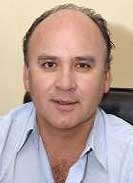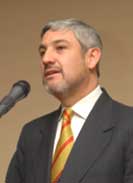Chile
January, 2007
By Sophie Harrison
bUSiness Chile, the magazine of
Chilean- North American
Chamber of Commerce
via
ANPROS, Chilean Seed Producers Association
In 1980, Chile exported seeds worth just US$2 million; today, it
is one of the world’s leading exporters but, say producers,
their success is fragile in the face of a strong currency.
 |
|
"Chile boasts technology that would be the
envy of any seed-producing country.”
Jaime Ibieta, President, National Association of
Seed Producers. |
|
| |
 |
|
“Intellectual property rights have to be
assured.”
Víctor Venegas, Director of International
Affairs, ODEPA. |
|
| |
 |
|
“All the big seed companies now recognize
Chile as an important country.” Martin van
Vaals, Executive Director, Food & Agribusiness
Research, Rabobank. |
|
This is a little known triumph.
While wine, fruit or salmon took the headlines, Chile’s seed
export industry was growing quietly but steadily, helped by
natural advantages and skillful management.
“Within Chile’s agricultural businesses, seed production has
been one of the few to achieve sustained growth,” maintains
Jaime Ibieta, president of the National Association of Seed
Producers (ANPROS) and manager for South American operations at
Nunhems, the Dutch multinational seed company.
Chile’s main advantage in this business comes from its position
as a counter-season producer - a southern hemisphere country
growing seeds for clients in the north. And while this is also
true for many of Chile’s other agricultural industries, the
advantage is magnified in the seed industry because the time
taken to produce seeds is so short.
“You can watch what happens in, say, the U.S. and then plant
what you know they’ll need six months later,” explains Ibieta.
“With fruit, changing direction like that would take years.”
Other geographical advantages also work in Chile’s favor. The
country has its natural isolation, surrounded as it is by
desert, mountains and ocean. And this, combined with a hot dry
climate, reduces the likelihood of plants suffering from
bacterial and fungal infections.
“All the big seed companies now recognize Chile as an important
country for the multiplication of seeds,” noted Martin van
Vaals, executive director for food and agribusiness research at
the specialist bank, Rabobank, during a recent ANPROS seminar on
intellectual property protection in Chile’s seed business.
However, it is not just natural advantages that have fostered
Chile’s success. Seeds are a high-quality product and are
technically challenging. “One thing that makes seed companies
different from other businesses is that you’ll find many people
have worked for them for a long time,” said van Vaals.
“Knowledge is extremely important and the people are a real
asset.”
Of the 75 members of ANPROS, 18 are multinationals. And these
big international companies, like Monsanto and DuPont, have
brought to Chile expertise which has filtered through to local
producers.
Today, Chile boasts technology that would be the envy of any
seed-producing country, says Ibieta. Maize, which is among the
most technically demanding crops to process for seeds, accounts
for close to half of Chile’s exports, and one of the biggest
maize processing plants in the world, owned and run by Pioneer,
a subsidiary of DuPont, is in Paine, just south of Santiago.
Chile’s seed industry also has sophisticated Global Positioning
Systems (GPS) to track plantings and avoid similar crops being
sown too close together and cross-pollinating. These were put in
place both by ANPROS and the Servicio Agrícola y Ganadero (SAG),
Chile’s agricultural inspection service.
The SAG is credited with having played an important role in
strengthening Chile’s natural barriers against disease and
contamination. “In other South American countries, the situation
is more complicated and they take things far less seriously,”
says Ibieta. “Chile can sometimes be a little bureaucratic but,
in the end, foreign companies have confidence in Chile because
they know there is greater security here.”
Testing Times
Last year, Chile’s seed exports reached US$172 million, making
it the leading southern hemisphere exporter and around the fifth
largest globally. Maize seeds, which are often genetically
modified, accounted for sales of US$65 million, followed by
seeds for vegetables, such as lettuces, cabbages, leeks, onions
and tomatoes, at US$41 million, while other important seed crops
include flowers (US$14 million), sunflowers, beans and grasses.
Organic seeds make up only a fraction of the total and are,
according to Ibieta, very tricky.
The total area under cultivation for seeds in Chile is now
estimated at 36,000 hectares. And, today, the seed industry
generates 7,000 permanent jobs, employing a large number of
women who do the bulk of the manual cross-pollination needed for
many vegetables and flowers.
As regards the destination of exports, 55% go to the United
States, which is the principal market for maize seeds, and 30%
to European countries. Chile’s Achilles heel is its distance
from its customers, which adds to costs that are already
significantly higher than third-world competitors notes Ibieta.
The industry’s challenge now is to maintain its competitiveness,
and one urgent necessity on this front is to improve the
situation regarding intellectual property. Speaking at the
recent ANPROS seminar, Víctor Venegas, director of international
affairs at the Chilean government’s Agricultural Research and
Policies Office (ODEPA), was emphatic on this point.
“Chile needs to broaden its base away from natural resources,”
said Venegas, who has participated in the negotiation of all the
country’s main Free Trade Agreements. “And for that we need
credibility; intellectual property rights have to be assured.”
Despite the best efforts of the SAG and its inspectors, too many
seeds in Chile are produced and sold informally. And, as Venegas
explained, this directly affects research and development
because, when a competitor appropriates a patented product, the
developer is forced to lower its prices, undermining the return
on its investment.
Chile is now working towards modifying its legislation and,
within the next two years, aims to comply with the UPOV 91
principles established by the International Union for the
Protection of New Varieties of Plants (UPOV). This would oblige
producers to pay for intellectual property rights and “is an
opportunity, not a threat,” said Venegas.
According to Ibieta, the seed industry also needs to make itself
better known within Chile and so carry more weight. “We have
been rather silent…despite being strong economically,” he says.
Seed exporters generate more revenues than meat or milk
exporters, but are a less powerful group. Moreover, key issues
like genetic modification, organic cultivation and intellectual
property are not generally well understood. “If the industry
were better understood in this country, it would enable it to
grow more,” maintains Ibieta.
But all these concerns are dwarfed by the anxiety of Chile’s
seed producers on account of the strength of the peso against
the U.S. dollar. “Two years ago, the dollar was at 750 pesos,
now it’s at 525 and costs have increased,” points out Ibieta.
“The multinationals are alright but Chilean seed businesses will
go under if there isn’t a solution,” he predicts. “What was once
business for them isn’t good business anymore.” |